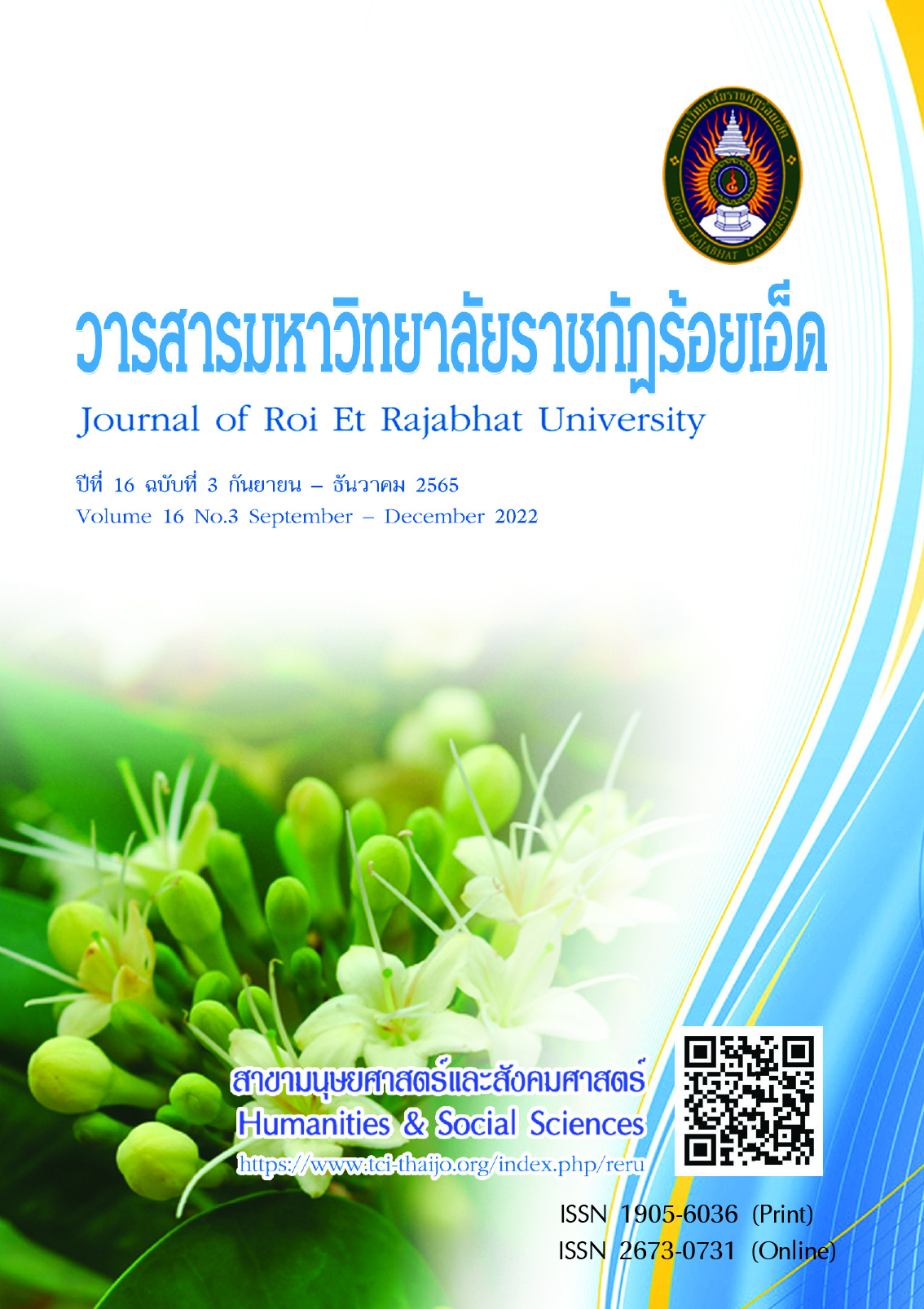Innovative Leadership of School Administrators affecting Teaching Behavior of Teachers in Surin Primary Education Service Area Office 2
Keywords:
Innovative leadership, Teaching behavior of teachers, Surin primary education service area office 2, Surin primary education service area office 2Abstract
The purposes of this research were to study 1) innovative leadership of school administrators,
2) teaching behavior of teachers, and 3) innovative leadership of school administrators affecting teaching behavior of teachers. The sampling group consisted of 472 school administrators and teachers in Surin primary education service area office 2 by Taro Yamane’s formula. Proportional random sampling by district areas and simple random sampling were utilized to select the participants for the study. The sampling group consisted of 472 school administrators and teachers in Surin primary education service area office 2 by Taro Yamane’s formula. Proportional random sampling by district areas and simple random sampling were utilized to select the participants for the study. Research instrument for collecting the data was a five - point rating scale questionnaire. The consistency index of each item was 0.6 - 1.00. The reliability
in innovative leadership of school administrators was 0.837 and the reliability in teaching behavior of teachers was 0.798. Statistical analysis of the data involved percentage, mean, standard deviation and correlation of Pearson Product Moment. Stepwise multiple regression was employed to test the hypothesis.
The findings of the research revealed that; 1) the innovative leadership of administrators as an overall was a high level. When considering in each aspect, there were 4 aspects also rated at a high level except the aspect of teamwork, and creating of innovation organization which was also rated at the highest. 2) the behavior of teaching as an overall was a high level. When considering in each aspect, the aspect of learning management, and measurement and evaluation which was also rated at the highest. And 3) the four aspects of innovative leadership of administrators affecting behavior of teaching; motivated creation (X5), problem solving and creating innovative (X3), creativity (X2), and change in vision (X1). These predictors could affect and predict 23.30 percent of behavior of teaching with statistical significance at the .05 level. These could be formed as the regression equations of unstandardized score and standardized score as follows;
The Regression Equation of Unstandardized Score:
Y´ = 2.843 + 0.138X + 0.104X3 + 0.081X + 0.058X1
The Regression Equation of Standardized Score:
Z´y = 0.238ZX5 + 0.212ZX3 + 0.151ZX2 + 0.096ZX1
References
กันตยา เพิ่มผล. (2543). การพัฒนาประสิทธิภาพในการทำงาน (พิมพ์ครั้งที่ 2). กรุงเทพฯ: สถาบันราชภัฏสวนดุสิต.
กีรติ ยศยิ่งยง. (2552). องค์กรแห่งนวัตกรรม. กรุงเทพฯ: จุฬาลงกรณ์มหาวิทยาลัย.
ขวัญฤดี ธราธารกุลวัฒนา. (2556). ความสัมพันธ์ระหว่างภาวะผู้นำทางวิชาการของผู้บริหารสถานศึกษากับพฤติกรรมการสอนของครูในสถานศึกษาขั้นพื้นฐาน โรงเรียนสังกัดเทศบาลเมืองกาญจนบุรี. วิทยานิพนธ์ ครุศาสตรมหาบัณฑิต สาขาวิชาการบริหารการศึกษา. กาญจนบุรี: มหาวิทยาลัยราชภัฏกาญจนบุรี.
เฉลิมพร เย็นเยือก. (2550). ผู้นำเชิงนวัตกรรม. เศรษฐศาสตร์และบริหารธุรกิจปริทัศน์, 3(2), 81–93.
ชาญณรงค์ พรรุ่งโรจน์. (2546). ความคิดสร้างสรรค์. กรุงเทพฯ: จุฬาลงกรณ์มหาวิทยาลัย.
ทองทิพภา วิริยะพันธุ์. (2551). มนุษยสัมพันธ์กับการบริหาร (พิมพ์ครั้งที่ 5). กรุงเทพฯ: สหธรรมมิก.
ทิวากร สุทธิบาก. (2557). ความสัมพันธ์ระหว่างพฤติกรรมผู้นำทางวิชาการของผู้บริหารสถานศึกษากับพฤติกรรมการสอนของครูในสถานศึกษา สังกัดสำนักงานเขตพื้นที่การศึกษาประถมศึกษาร้อยเอ็ด เขต 2. วิทยานิพนธ์ ครุศาสตรมหาบัณฑิต สาขาวิชาการบริหารการศึกษา. ร้อยเอ็ด: มหาวิทยาลัยราชภัฏร้อยเอ็ด.
ทิศนา แขมมณี. (2542). การจัดการเรียนการสอนโดยยึดผู้เรียนเป็นศูนย์กลาง: ซิปปาโมเดล. วารสารวิชาการกรมวิชาการ, 2(4), 12–17.
บุญชม ศรีสะอาด. (2556). การวิจัยเบื้องต้น (พิมพ์ครั้งที่ 9). กรุงเทพฯ: สุวีริยาสาส์น.
ประพันธ์ศิริ สุเสารัจ. (2551). การพัฒนาการคิด (พิมพ์ครั้งที่ 2). กรุงเทพฯ: เทคนิคพริ้นติ้ง.
พิมพันธ์ เดชะคุปต์. (2560). ทักษะ 7C ของครู 4.0 (พิมพ์ครั้งที่ 2). กรุงเทพฯ: สำนักพิมพ์จุฬาลงกรณ์มหาวิทยาลัย.
พยัต วุฒิรงค์. (2555). การจัดการนวัตกรรมจากแนวคิดสู่การปฏิบัติที่เป็นเลิศ. กรุงเทพฯ: จุฬาลงกรณ์มหาวิทยาลัย.
ไพฑูรย์ สินลารัตน์. (2551). การเปลี่ยนผ่านการศึกษาเข้าสู่ยุคเศรษฐกิจฐานความรู้ (พิมพ์ครั้งที่ 2). กรุงเทพฯ: จุฬาลงกรณ์มหาวิทยาลัย.
ภารดี อนันต์นาวี. (2555). หลักการ แนวคิด ทฤษฎีทางการบริหารการศึกษา (พิมพ์ครั้งที่ 4). ชลบุรี: มนตรี.
รัชนีเพ็ญ พลเยี่ยม. (2560). การวิจัยทางการศึกษา Educational Research. มหาสารคาม: อภิชาตการพิมพ์.
ลำพอง บุญช่วย. (2530). การสอนเชิงระบบ (พิมพ์ครั้งที่ 2). ปทุมธานี: วิทยาลัยครูเพชรบุรีวิทยาลงกรณ์.
วัชรพงศ์ ทัศนบรรจง. (2563). ภาวะผู้นำเชิงนวัตกรรมของผู้บริหารที่ส่งผลต่อประสิทธิผลของสถานศึกษาในโครงการโรงเรียน ประชารัฐ สังกัดสำนักงานเขตพื้นที่การศึกษาประถมศึกษาสมุทรสงคราม. วิทยานิพนธ์ ครุศาสตรมหาบัณฑิต สาขาวิชาการบริหารการศึกษา. นครปฐม: มหาวิทยาลัยราชภัฏนครปฐม.
วิชัย วงษ์ใหญ่ และมารุต พัฒผล. (2562). การพัฒนาทักษะสร้างสรรค์นวัตกรรม. กรุงเทพฯ: ศูนย์ผู้นำนวัตกรรมหลักสูตรและการเรียนรู้.
วิไลพร ธนสุวรรณ. (2537). วัฒนธรรมกับการเรียนการสอนภาษาอังกฤษ. คณะศึกษาศาสตร์. เชียงใหม่: มหาวิทยาลัยเชียงใหม่.
เวียงวิวรรธน์ ทำทูล. (2557). ภาวะผู้นำเชิงนวัตกรรมของผู้บริหารที่ส่งผลต่อองค์การขีดสมรรถนะสูงของโรงเรียนในสังกัดสำนักงานเขตพื้นที่การศึกษามัธยมศึกษา เขต 21. วิทยานิพนธ์ ศึกษาศาสตรมหาบัณฑิต สาขาวิชาการบริหารการศึกษา. ขอนแก่น: มหาวิทยาลัยขอนแก่น.
สมใจ ลักษณะ. (2546). การพัฒนาประสิทธิภาพในการทำงาน. (เอกสารประกอบการสอน). กรุงเทพฯ: สถาบันราชภัฏสวนสุนันทา.
สมใจ ลักษณะ. (2543). การพัฒนาประสิทธิภาพในการทำงาน. (เอกสารประกอบการสอน). กรุงเทพฯ: สถาบันราชภัฏสวนสุนันทา.
สุดา ทัพสุวรรณ. (2541). หน้าที่ของผู้นำในการบริหารการศึกษา. กรุงเทพฯ: มหาวิทยาลัยศรีนครินทรวิโรฒ.
สุพิน บุญชูวงศ์. (2533). หลักการสอน. กรุงเทพฯ: แสวงสุทธิการพิมพ์.
สำนักงานเขตพื้นที่การศึกษาประถมศึกษาสุรินทร์ เขต 2. (2563). แผนปฏิบัติการประจำปีงบประมาณ พ.ศ. 2564. สุรินทร์: กลุ่มนโยบายและแผน สำนักงานเขตพื้นที่การศึกษาประถมศึกษาสุรินทร์ เขต 2.
สำนักวิชาการและมาตรฐานการศึกษา. (2552). ตัวชี้วัดและสาระการเรียนรู้ ตามหลักสูตรแกนกลางการศึกษาขั้นพื้นฐาน พุทธศักราช 2551. กรุงเทพฯ: โรงพิมพ์ชุมนุมสหกรณ์การเกษตรแห่งประเทศไทย จำกัด.
สำนักงานนวัตกรรมแห่งชาติ. (2547). สุดยอดนวัตกรรมไทย. กรุงเทพฯ: สำนักงานนวัตกรรมแห่งชาติ.
อนุสรา สุวรรณวงศ์. (2559). ภาวะผู้นำเชิงนวัตกรรม (Innovative Leadership). สืบค้นเมื่อ 4 ธันวาคม 2561,
จาก https://www.trueplookpanya.com/education/content/52233/-edu-teaartedu-teaart-teaartdir
อรอนงค์ โรจน์วัฒนบูลย์. (2553). การพัฒนาตัวแบบผู้นำเชิงนวัตกรรม. กรุงเทพฯ: สถาบันบัณฑิต พัฒนบริหารศาสตร์.
อรรถพล เทินสะเกษ และยุวธิดา ชาปัญญา. (2563). ภาวะผู้นําทางวิชาการของผู้บริหารสถานศึกษาที่ส่งผลต่อประสิทธิภาพการสอนของครู สำนักงานเขตพื้นที่การศึกษาประถมศึกษายโสธรเขต 1. วารสารมหาวิทยาลัยราชภัฏร้อยเอ็ด, 14(3), 199-207.
อาภรณ์ ใจเที่ยง. (2540). หลักการสอน (พิมพ์ครั้งที่ 2). กรุงเทพฯ: โอเอสพริ้นติ้งเฮาส์.
เอชอาร์ โน้ต (HR Note. Asia). (2021). อุปสรรคของการทำงานระบบทีมและการบริหารความขัดแย้งที่เกิดขึ้นภายในทีม. สืบค้นข้อมูลวันที่ 18 พฤษภาคม 2564, จากhttps://th.hrnote.asia/orgdevelopment/190510–team–conflict–management.
Charles, M. (2010). Five Competitive Forces of Effective Leadership and Innovation. Toronto: Emeraid Group Publishing.
Dave. (2007). Characteristics of Innovative Leaders. Retrieved December 8, 2019 from: http://innovativeleadership.blogspot.com/2007/02/nnovative–leadership–progress–at warp.html. Last update
Grady, T. P. and Malloch, K. (2010). Innovation Leadership: Creating the Landscape of Healthcare. Canada: Jones and Bartlett.
Hender, J. (2003). Innovation Leadership: Role and Key Imperatives. United Kingdom: Grist.
Horth, D. (2014). Innovation Leadership: How to Use Innovation to Lead Effectively, Work Collaboratively, and Drive Results. NC: Center for Creative Leadership.
Jong, J. P., & Den Hartog, D. N. (2007). How Leaders Influence Employees’ Innovative Behaviors. European Journal of Innovation Management, 10(1), 41–64.
Kuczmarski, T. D. (2003). What is Innovation? and Why aren’t Companies Doing More of it?. Journal of Consumer Marketing, 20(6), 536–541.
Paddy, M., Koen, K., Azta, B. and Freek, D. (2012). Innovation Leadership Study (Meaning Innovation:
An Insider Perspective). Navara: IESE Business School University.
Richard, L. (2009). The Innovator’s Toolkit. USA: Boston University.
Sen, A. and Eren, E. (2012). Innovation Leadership for the Twenty–first Century. Procedia–Social and Behavioral Sciences, 41: 1–14.
Smith, A. W. (1982). Management System: Analyses and Application. Tokyo: Holt–Saunders.
Tanya, R. (2010). The 7 Steps to Innovative Leadership. Retrieved December 12, 2019, http://www.centerdigitaled.com/polity/The–7–Elemeent–of–Innovative– Leadership.html
Vlok, A. (2012). A Leadership Competency Profile for Innovation Leaders in a Science–Based Research and Innovation Organization in South Africa. Procedia–Social and Behavioral Science, 41, 209–226.
Downloads
Published
How to Cite
Issue
Section
License
Copyright (c) 2022 Roi Et Rajabhat University

This work is licensed under a Creative Commons Attribution-NonCommercial-NoDerivatives 4.0 International License.
บทความที่ได้รับการตีพิมพ์เป็นลิขสิทธิ์ของวารสารมหาวิทยาลัยราชภัฎร้อยเอ็ด
ข้อความที่ปรากฏในบทความแต่ละเรื่องในวารสารวิชาการเล่มนี้เป็นความคิดเห็นส่วนตัวของผู้เขียนแต่ละท่านไม่เกี่ยวข้องกับมหาวิทยาลัยราชภัฎร้อยเอ็ด และคณาจารย์ท่านอื่นๆในมหาวิทยาลัยฯ แต่อย่างใด ความรับผิดชอบองค์ประกอบทั้งหมดของบทความแต่ละเรื่องเป็นของผู้เขียนแต่ละท่าน หากมีความผิดพลาดใดๆ ผู้เขียนแต่ละท่านจะรับผิดชอบบทความของตนเองแต่ผู้เดียว





